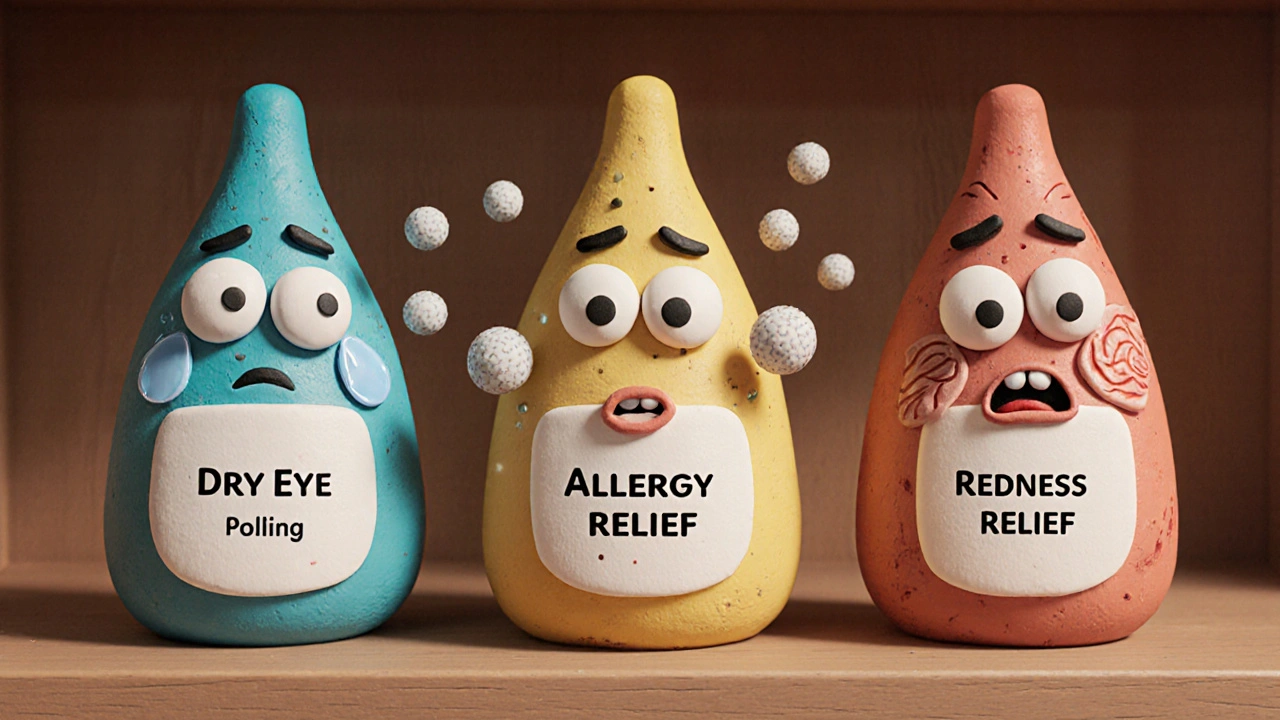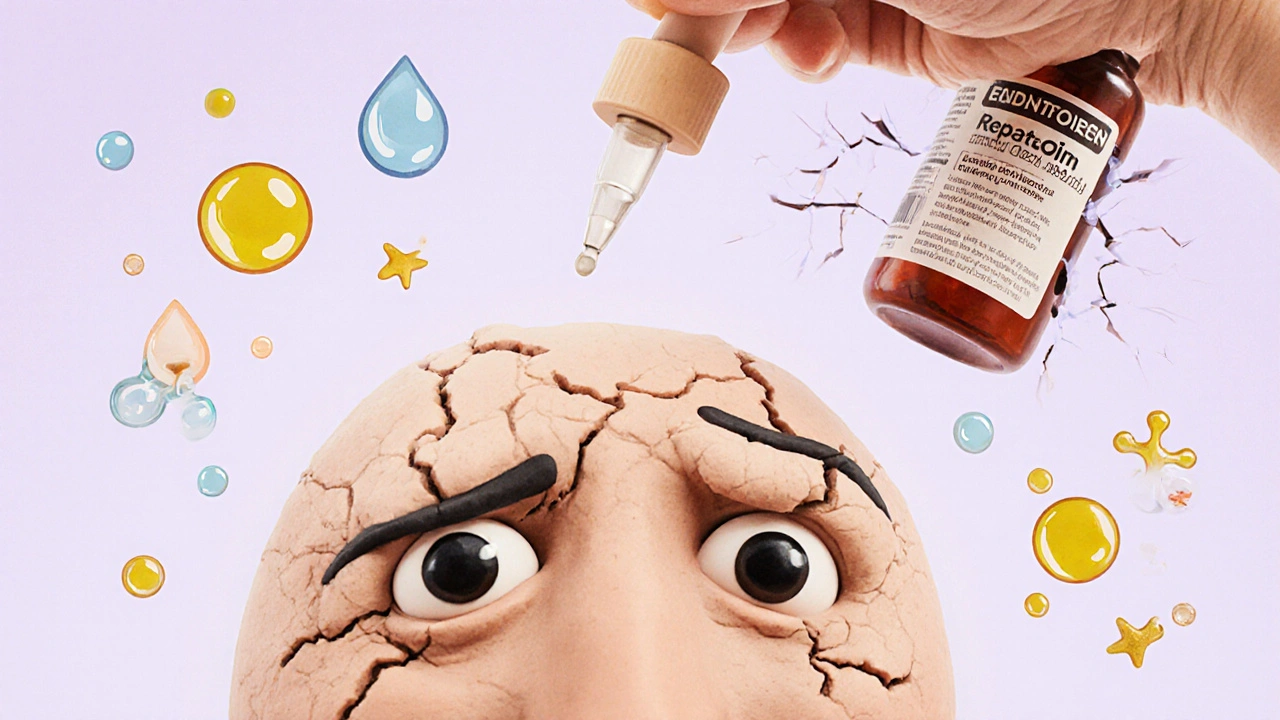How to Choose OTC Eye Drops for Allergies, Dryness, and Redness

What’s Really in Your Eye Drops?
Not all eye drops are made the same. If you’ve ever grabbed a bottle off the pharmacy shelf because your eyes felt gritty, itchy, or bloodshot, you’re not alone. But picking the wrong one can make things worse - not better. You might think all eye drops are just for comfort, but the ingredients inside them do very different things. Some hydrate. Some fight allergies. Some shrink redness. And using one for the wrong problem? That’s like putting gasoline in a diesel engine.
There are three main types of OTC eye drops you’ll see on the shelf: artificial tears for dryness, antihistamine drops for allergies, and vasoconstrictors for redness. Each targets a different cause. If you mix them up, you could end up with more irritation, longer-lasting redness, or even damage to your eye’s surface over time.
For Dry Eyes: Hydration Is Key
Dry eyes feel like sand under your eyelids. They sting after staring at a screen, burn in air-conditioned rooms, or get worse by the end of the day. This isn’t just about being tired - it’s usually a lack of quality tears. There are two main types: aqueous-deficient (not enough watery layer) and evaporative (tears evaporate too fast because the oily layer is missing).
For most people with mild to moderate dryness, standard artificial tears work fine. Look for ingredients like polyethylene glycol, propylene glycol, or sodium hyaluronate. Brands like Systane Ultra and Refresh Optive are popular because they mimic natural tears. But if you’re using them more than four times a day, go preservative-free. Preservatives like polyquaternium-1 can irritate your eyes over time - studies show up to 22% of frequent users develop tiny corneal scratches.
If your dryness is worse later in the day and you feel a burning sensation, you likely have evaporative dry eye. That means your tear film’s oily layer is failing. In that case, lipid-based drops like Systane Complete PF or Soothe XP are better. They contain mineral oil and castor oil to seal in moisture. Clinical data shows they reduce symptoms 52% more than regular drops.
For severe dry eye, single-use vials are the gold standard. Refresh Optive Preservative-Free or Thealoz Duo come in small, sterile doses. Thealoz Duo uses trehalose and sodium hyaluronate - a combo proven to improve corneal healing by 40% in clinical trials. These cost more - around $12 to $22 for 30 vials - but if you’re using drops daily, they’re worth it.
For Allergies: Antihistamines Work Faster Than You Think
If your eyes water, itch, and swell when pollen is in the air - or when you’re around pets or dust - you need an antihistamine eye drop. These aren’t the same as oral allergy pills. Eye drops act right where the problem is.
The two strongest OTC options are ketotifen (found in Zaditor) and olopatadine (Pataday). Pataday is stronger. One drop lasts up to 24 hours. Zaditor usually needs two doses a day. Both are non-drowsy and safe for long-term use during allergy season.
Don’t use redness-relief drops for allergies. They might make your eyes look whiter temporarily, but they don’t touch the itch or swelling. And if you use them often, you’ll get rebound redness - your eyes turn even redder after the effect wears off.
Real user feedback on Reddit’s r/dryeye community shows that people who switch from Visine to Pataday report a 70% drop in itching within days. One user wrote: “I thought my eyes were just dry. Turns out, it was pollen. Pataday fixed it in one day.”

Redness Relief: The Trap Most People Fall Into
Red eyes? It’s tempting to grab Visine, Clear Eyes, or even Bausch + Lomb Lumify. They promise quick whitening. But here’s the truth: vasoconstrictors like tetrahydrozoline (in Visine) or naphazoline (in Opcon-A) shrink blood vessels to make eyes look less red. That’s it. They don’t treat the cause.
Here’s the problem: your eyes need blood flow to make tears and heal. When you shrink those vessels repeatedly, your eyes become dependent. After a few days, the redness comes back worse. Studies show 68% of frequent users develop rebound redness within two weeks. And if your redness is actually from dryness or allergies, these drops make it worse by cutting off blood flow to the surface.
Lumify (brimonidine tartrate 0.025%) is a newer option. It’s designed to have less rebound effect. Clinical trials show only 5.2% of users get rebound redness - compared to 68% with traditional drops. But it’s not for everyone. Some users report headaches or a bitter taste after use.
The American Optometric Association’s 2024 guidelines say it clearly: “Never use redness-relief drops for dry eye.” And yet, 67% of dry eye patients in a 2023 survey started with these drops. By week two, 82% said their symptoms got worse.
How to Use Eye Drops Right
Even the best drop won’t work if you use it wrong. Most people blink right after applying it - washing the medicine out. Or they touch the dropper to their eye, risking contamination.
Here’s the correct way:
- Tilt your head back slightly.
- Pull down your lower eyelid to make a small pocket.
- Hold the bottle above your eye - don’t touch your eye or lashes.
- Squeeze one drop in.
- Close your eye gently for 30 seconds. Press lightly on the inner corner near your nose to keep the drop from draining too fast.
- Wait five minutes before applying another drop, if needed.
Wash your hands before and after. Don’t share bottles. Store them at room temperature unless the label says otherwise - Thealoz Duo needs refrigeration after opening.
What to Avoid
- Don’t use redness drops for dryness or allergies. They mask symptoms, not fix them.
- Don’t use preserved drops more than four times a day. Switch to preservative-free if you need frequent relief.
- Don’t use drops past their expiration date. Even if they look fine, they can grow bacteria.
- Don’t use drops for more than 30 days after opening. Most multi-dose bottles are only sterile for 28-30 days after first use.
- Don’t ignore persistent symptoms. If your eyes are still red, dry, or itchy after two weeks of proper use, see an eye doctor. You might have an underlying condition like blepharitis or meibomian gland dysfunction.

Top Picks by Condition (2025)
| Condition | Best Product | Key Ingredient | Duration | Preservative-Free? | Price Range (AUD) |
|---|---|---|---|---|---|
| Mild Dry Eye | Systane Ultra | Polyethylene glycol, propylene glycol | 8-10 hours | No | $12-$18 |
| Evaporative Dry Eye | Systane Complete PF | Mineral oil, castor oil | 6-8 hours | Yes | $20-$25 |
| Severe Dry Eye | Thealoz Duo | Trehalose 3%, sodium hyaluronate 0.15% | 4-6 hours | Yes | $22-$28 |
| Allergies | Pataday (olopatadine) | Olopatadine 0.1% | 24 hours | No | $18-$22 |
| Redness (Short-Term Only) | Lumify | Brimonidine tartrate 0.025% | 8 hours | No | $16-$20 |
What If Nothing Works?
If you’ve tried the right type of drops, used them correctly, and still feel discomfort after two weeks, it’s time to see an eye care professional. Dry eye isn’t always just about tears. It can be linked to autoimmune conditions, medications, or even eyelid inflammation. Allergies might need prescription-strength drops. Redness could signal an infection or glaucoma.
There’s no shame in getting help. OTC drops are great for temporary relief - but they’re not a cure-all. Your eyes are delicate. Treat them like you’d treat your skin: with care, the right tools, and professional advice when needed.
Can I use OTC eye drops every day?
Yes - but only if you’re using the right kind. Artificial tears and allergy drops can be used daily. If you’re using them more than four times a day, switch to preservative-free versions. Avoid redness-relief drops for daily use - they can cause rebound redness and make your eyes worse over time.
Do eye drops expire?
Yes. Most unopened bottles last 1-3 years. Once opened, multi-dose bottles are only good for 28-30 days. Single-use vials should be thrown away after one use, even if there’s leftover liquid. Expired or contaminated drops can cause infections.
Why do my eyes sting when I use eye drops?
Stinging usually means the drop has preservatives your eyes don’t tolerate, or you’re using the wrong type for your condition. Try switching to a preservative-free formula. If stinging continues, you may have sensitive eyes or an underlying issue like corneal abrasion - see an eye doctor.
Can I use eye drops with contact lenses?
Only if they’re labeled “for contact lens wearers.” Regular drops can stick to lenses and cause irritation. Blink Contacts, Refresh Contacts, and Soothe XP are designed to be safe with contacts. Always wait 15 minutes after inserting lenses before using drops - or use them before putting lenses in.
Are expensive eye drops better?
Not always. Generic artificial tears work fine for mild dryness. But for severe dry eye, evaporative dry eye, or allergies, premium formulations like Thealoz Duo or Systane Complete PF have proven ingredients that work better. You’re paying for targeted science, not just branding.
How do I know if I have dry eye or allergies?
Dry eye usually feels gritty, tired, or burning - especially after screen use or in dry air. Allergies cause intense itching, watery eyes, and swelling - often with sneezing or a runny nose. If you’re not sure, try an antihistamine drop. If itching stops, it was allergies. If it doesn’t, you likely have dry eye.
Next Steps
Start by identifying your main symptom: is it dryness, itch, or redness? Pick the right type of drop. Use it correctly. Give it two weeks. If things don’t improve - or if they get worse - book an eye exam. Don’t wait until it hurts. Your eyes are one of your most important senses. Treat them like it.

Aidan McCord-Amasis
November 16, 2025 AT 11:03Katie Baker
November 18, 2025 AT 06:39BABA SABKA
November 19, 2025 AT 13:22Kihya Beitz
November 20, 2025 AT 04:44ASHISH TURAN
November 21, 2025 AT 20:23Adam Dille
November 23, 2025 AT 09:48Jennifer Walton
November 23, 2025 AT 16:11Ryan Airey
November 25, 2025 AT 01:55Jonathan Dobey
November 25, 2025 AT 09:23Hollis Hollywood
November 26, 2025 AT 05:42Chris Bryan
November 26, 2025 AT 07:10